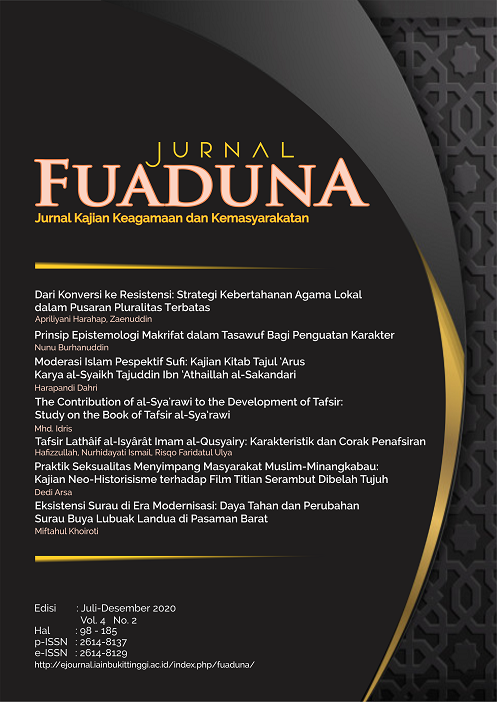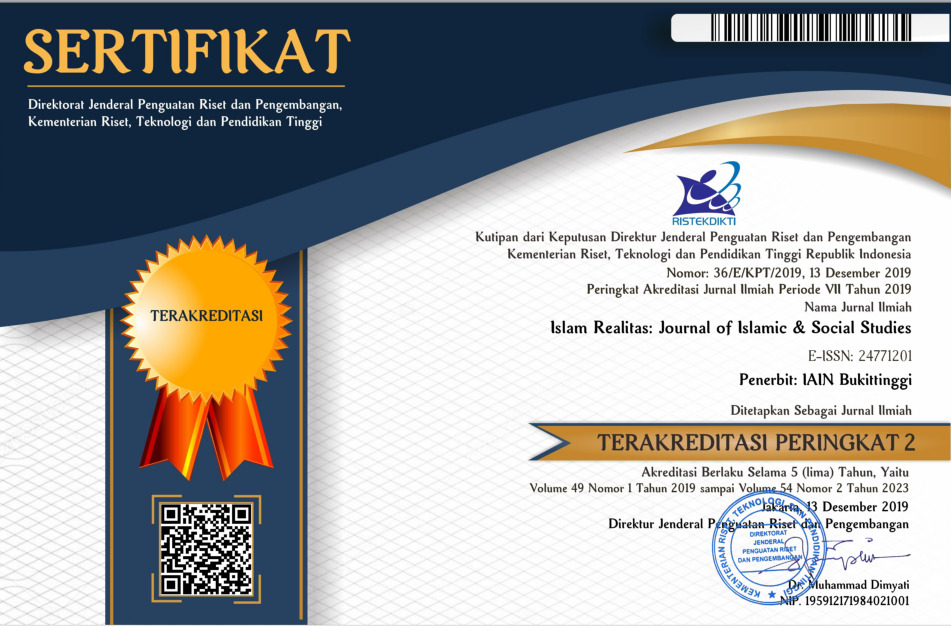Praktik Seksualitas Menyimpang Masyarakat Muslim-Minangkabau: Kajian Neo-Historisisme terhadap Film Titian Serambut Dibelah Tujuh
DOI:
https://doi.org/10.30983/fuaduna.v4i2.3406Keywords:
Sexuality, Flm, Muslim-MinangkabauAbstract
This article discusses the practices of deviant sexuality in the Muslim-Minangkabau community depicted in early Indonesian films in relation to the socio-cultural context in the film as well as the socio-cultural context when the film was produced. The film in question is Titian Serambut Dibelah Tujuh by Asrul Sani. In this film some of the deviant practices of sexuality depicted are homosexuality, lesbianity, and hypersexuality (through the practice of rape). Using a neo-historicalism approach, which looks at the relation of literary texts (films) to their historical space and time, the narratives in this film relate to the context of their presence in the midst of Indonesian social reality and the setting of the film itself: this film exists as a critique of moral decadence The Old Order, which celebrates sexuality in public spaces and on the other hand, also describes the background society (which is also where the writer of the scenario came from) where the practices of sexuality diverged have their own traces in the history of this society.
Artikel ini membahas praktik-praktik seksualitas menyimpang di tengah masyarakat Muslim-Minangkabau yang digambarkan dalam film Indonesia awal dalam relasinya dengan konteks sosial-budaya dalam film maupun konteks sosial-budaya ketika film ini diproduksi. Film yang dimaksud adalah Titian Serambut Dibelah Tujuh karya Asrul Sani. Dalam film ini beberapa praktik seksualitas menyimpang yang digambar adalah homoseksualitas, lesbianitas, dan hiperseksualitas (lewat praktik perkosaan). Dengan menggunakan pendekatan neo-historisisme, yang melihat relasi teks sastra (film) dengan ruang dan waktu historisnya, narasi-narasi dalam film ini terkait dengan konteks kehadirannya di tengah realitas sosial Indonesia dan latar filmnya itu sendiri: film ini hadir sebagai kritik atas dekadensi moral Orde Lama yang merayakan binalitas-seksualitas di ruang publik dan di sisi lain, juga menggambarkan masyarakat latar (yang juga dari mana si penulis skenarionya berasal) di mana praktik-praktik seksualitas menyimpang punya jejaknya tersendiri dalam sejarah puak ini.
References
Abdullah, Taufik. “Adat and Islam: An Examination of Conflict in Minangkabau".†Indonesia, no. 2 (1966).
Agus, Bustanuddin. “Islam Dan Budaya Minang: Suatu Kebutuhan Dalam Menatap Masa Depanâ€.†Padang, 2004.
Anwar, Rosihan. “Asrul Sani Pribadi Religius.†Republika, 2004.
Arief, Muhammad. “Analisis Konteks Islam Dan Budaya Minangkabau Dalam Skenario Film Titian Serambut Dibelah Tujuh".†Menara Ilmu X, no. 73 (2016): 213–216.
Arsa, Dedi. “Kaum Komunis Dan Islam Reformis Dalam Roman-Roman Abdoelxarim M.S.â€.†Jentera 8, no. 1 (2019): 28–29.
———. “Padangan Karya-Karya Fiksi Atas Nasib Perempuan Minangkabau Korban Pemberontakan Daerah/PRRI 1958-1961".†Humanisma: Journal of Gender Studies 1, no. 2 (2011): 1–12.
dkk, Robin Headlam Wells. Neo-Historicism: Studies in Renaissance Literature, History, and Politics. Cambridge: D.S. Brewer, 2000.
Erman, Erwiza. Miners, Managers and the State: A Socio-Political History of the Ombilin Coal-Mines, West Sumatra, 1892-1996â€. Disertasi, Universiteit van Amsterdam, 1999.
Garaghan, G J. A Guide to Historical Method. New York: Fordham University Press, 1984.
Hadler, Jeffrey. Muslims and Matriarchs: Cultural Resilience in Indonesia Through Jihad and Colonialism. Ithaca and London: Cornell University Press, 2008.
Huda, Ahmad Nuril. “Negotiating Islam with Cinema: A Theoretical Discussion on Indonesian Islamic Films, Wacana: Jurnal Ilmu Pengetahuan Budaya,†2012.
Kartodirdjo, Sartono. Pendekatan Ilmu Sosial Dalam Metodologi. Jakarta: Gramedia, 1993.
Kato, Tsuyoshi. “Change and Continuity in the Minangkabau Matrilineal Systemâ€.†Indonesia 25 (1978): 1–16.
Melalatoa, M.Junus. Ensiklopedi Suku Bangsa Di Indonesia. Jakarta: Departeman P & K, 1995.
Murtagh, Ben. Genders and Sexualities in Indonesian Cinema: Constructing Gay, Lesbi and Waria Identities on Screen. London: Routledge, 2013.
———. “Lesbi in the Metropolis: Fatal Attraction in an Indonesian Movie from the Early 1990s.†Review of Indonesian and Malaysian Affairs 45 (2011).
Nuryanti, Reni. “Perempuan, Seks, Dan Perang: Analisis Dalam Pergolakan Pemerintah Revolusioner Republik Indonesia (PRRI) (1958-1961)â€.†In Proceedings. Padang: BPSNT Padang Press dan Fakultas Sastra Unand, 2011.
Pertiwi, Gema, and Yusril. “Penciptaan Film Fiksi Siriah Jadi Karakok Dengan Fenomena Lesbian Di Sumatera Barat, Gorga: Jurnal Seni Rupa,†2019.
Popper, Karl. The Open Society and Its Enemies. Princeton: Princeton UP, 1971.
Rampan, Korrie Layun. Leksikon Susastra Indonesia. Jakarta: Balai Pustaka, 2000.
Reki, Afrino. “Studi Fenomenologi: Konsep Diri Homoseksual (Lesbian) Di Kota Padang,†2016.
Rosidi, Ajip. Mengenang Hidup Orang Lain: Sejumlah Obituari. Jakarta: Kepustakaan Populer Gramedia, 2010.
Sasono, Eric. “Islamic Revivalism and Religious Piety in Indonesian Cinema,†2013.
———. “Muslim Sosial Dan Pembaharuan Islam Dalam Beberapa Film Indonesia",†2011.
Selden, Raman, and Peter Widdowson. A Reader’s Guide to Contemporary Literary Theory. The University Press of Kentucky, 1993.
Stark, Alexander. “The Matrilineal System of the Minangkabau and Its Persistence Throughout History: A Structural Perspective".†Southeast Asia: A Multidisciplinary Journal 13 (2013): 1–13.
Sufyan, Fikrul Hanif, and Dedi Arsa. “Kuda Bendi Di Kota Payakumbuh Sumatera Barat Sampai Akhir Abad Ke-20".†Mozaik Humaniora 17, no. 1 (2017).
Sugono, Dendy, ed. “Ensiklopedia Sastra Indonesia Modern.†In Pusat Bahasa, 45–48. Jaka: Pusat Bahasa, 2003.
Whalley, Lucy A. Meletakkan Islam Ke Dalam Praktik. Perkembangan Islam dalam Perspektif Gender Minangkabauâ€, 1996.
Wicaksono, Andri. “Sejarah Politik Indonesia Dalam Novel Larasati Karya Pramoedya Ananta Toerâ€.†Jentera 7, no. 1 (2018).
Woodward, Mark R, ed. “Jalan Baru Islam: Memetakan Paradigma Mutakhir Islam Indonesia,†207. Bandung: Mizan, 1996.
Downloads
Published
How to Cite
Issue
Section
Citation Check
License
Authors who publish with this journal agree to the following terms:
- Authors retain copyright and grant the journal right of first publication with the work simultaneously licensed under a Creative Commons Attribution-ShareAlike 4.0. that allows others to share the work with an acknowledgment of the work's authorship and initial publication in this journal.
- Authors are able to enter into separate, additional contractual arrangements for the non-exclusive distribution of the journal's published version of the work (e.g., post it to an institutional repository or publish it in a book), with an acknowledgment of its initial publication in this journal.
- Authors are permitted and encouraged to post their work online (e.g., in institutional repositories or on their website) prior to and during the submission process, as it can lead to productive exchanges, as well as earlier and greater citation of published work (See The Effect of Open Access).





